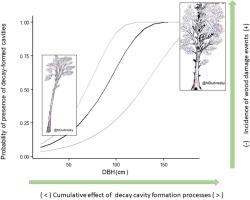Forest Ecology and Management ( IF 3.7 ) Pub Date : 2021-05-04 , DOI: 10.1016/j.foreco.2021.119295 Natalie Dudinszky , Silvina Ippi , Thomas Kitzberger , Gerardo Cerón , Valeria Ojeda

|
Maintenance of tree cavity supply is a global conservation priority for forest wildlife, which requires understanding the ecology and population dynamics of cavity-bearing trees. Explaining the occurrence of cavities in trees is particularly important in ecosystems where most secondary cavity-users (SCUs) are critically dependent on the slow formation of cavities by wood-decay processes. Our main objectives were (1) to explain the distribution of decay cavities in trees according to their individual attributes and, (2) to quantify the relative importance of each individual tree attribute to determine the presence of decay cavities. We focused on medium and large decay cavities (smallest entrance dimension ≥ 5 cm), which can limit populations of management-sensitive SCUs. We measured forest attributes and inspected cavities in trees (n = 860) and snags (n = 93) in six 0.5 ha plots from old- and second-growth Nothofagus dombeyi forest stands. We used generalised linear mixed-effects models (GLMM) to analyse the distribution of decay cavities in trees using data on their presence/absence, based on several tree individual attributes, across different sites. We applied an information-theoretical and multi-model inference approach to quantify the strength of alternative sets of hypotheses/models. We used model averaging, which allows estimating coefficients and making inferences that account for model and parameter uncertainty. Diameter at breast height (DBH), crown damage and decay, crown ratio (crown length • trunk length−1) and woodpecker foraging signs were important to explain the presence/absence of decay cavities in trees. Diameter at breast height, woodpecker foraging signs and a moderate-high crown damage and decay were positively related with decay cavity presence. The presence of medium and large decay cavities was also positively related with DBH, but trees with low crown ratios had relatively low probabilities of presenting these cavities, even with DBHs > 150 cm. Trees with DBHs smaller than 50 cm had very low probabilities (<0.25–0.30) to present decay cavities, while the probability of trees presenting decay cavities of medium and large sizes was very low for trees with diameters < 100 cm, even for trees with high crown ratios. Our results point out that conservation of large diameter trees with high crown ratios is important to maintain the supply of decay cavities required by management-sensitive SCUs in these forests. As these keystone structures are globally threatened by climate change induced disturbances (e.g. fires, droughts), they should be maintained/restored through forest management (e.g. retention of keystone structures) to achieve cavity-using wildlife habitat conservation in the long-term.
中文翻译:

树的大小和树冠结构说明了南美凉爽的森林中野生生物所需的空腔的存在
维持树洞供应是森林野生动植物的全球保护重点,这需要了解带有树洞的树木的生态和种群动态。解释树木中蛀洞的发生在生态系统中尤为重要,在生态系统中,大多数次要蛀牙使用者(SCU)严重依赖于木材腐烂过程缓慢形成的蛀牙。我们的主要目标是(1)根据树的各个属性来解释树木中蛀洞的分布,以及(2)量化每个树木属性的相对重要性,以确定是否存在蛀洞。我们专注于中型和大型衰减腔(最小入口尺寸≥5 cm),这会限制对管理敏感的SCU的数量。Nothofagus dombeyi森林林分。我们使用广义线性混合效应模型(GLMM),基于树木在不同地点的几个属性,使用它们存在/不存在的数据来分析树木中蛀蚀腔的分布。我们应用了一种信息理论和多模型推理方法来量化假设/模型的备选集的强度。我们使用模型平均,可以估计系数并进行推断,以解释模型和参数的不确定性。胸高直径(DBH),牙冠损伤和衰变,牙冠比例(牙冠长度•躯干长度-1)和啄木鸟觅食迹象对于解释树木中是否存在蛀蚀洞很重要。乳房高度的直径,啄木鸟觅食的体征以及中等程度的高冠损伤和衰变与衰变腔的存在呈正相关。中等和较大的蛀牙洞的存在也与DBH呈正相关,但即使DBH> 150 cm,具有低树冠比率的树木出现这些洞的概率也相对较低。DBH小于50 cm的树具有衰减腔的概率非常低(<0.25–0.30),而直径小于100 cm的树出现中等和大尺寸衰减腔的概率非常低,即使直径小于100 cm的树也是如此。高冠比率。我们的结果指出,保护具有高树冠比率的大直径树木对于维持这些森林中对管理敏感的SCU所需的腐烂腔的供应非常重要。由于这些基石结构在全球范围内受到气候变化引发的干扰(例如,火灾,干旱)的威胁,因此应通过森林管理(例如,基石结构的保留)对其进行维护/恢复,以长期实现利用洞穴的野生动植物栖息地保护。



























 京公网安备 11010802027423号
京公网安备 11010802027423号